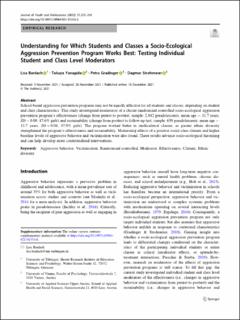| dc.contributor.author | Bardach, Lisa | |
| dc.contributor.author | Yanagida, Takuya | |
| dc.contributor.author | Gradinger, Petra | |
| dc.contributor.author | Strohmeier, Dagmar | |
| dc.date.accessioned | 2023-04-03T08:11:52Z | |
| dc.date.available | 2023-04-03T08:11:52Z | |
| dc.date.created | 2023-01-31T21:20:57Z | |
| dc.date.issued | 2022 | |
| dc.identifier.citation | Bardach, L., Yanagida, T., Gradinger, P., & Strohmeier, D. (2022). Understanding for which students and classes a socio-ecological aggression prevention program works best: Testing individual student and class level moderators. Journal of youth and adolescence, 51(2), 225-243. | en_US |
| dc.identifier.issn | 0047-2891 | |
| dc.identifier.uri | https://hdl.handle.net/11250/3061666 | |
| dc.description.abstract | School-based aggression prevention programs may not be equally effective for all students and classes, depending on student and class characteristics. This study investigated moderators of a cluster randomized controlled socio-ecological aggression prevention program’s effectiveness (change from pretest to posttest, sample: 2,042 preadolescents, mean age = 11.7 years, SD = 0.09, 47.6% girls) and sustainability (change from posttest to follow-up test, sample: 659 preadolescents, mean age = 12.7 years, SD = 0.08, 47.9% girls). The program worked better in multicultural classes, as greater ethnic diversity strengthened the program’s effectiveness and sustainability. Moderating effects of a positive social class climate and higher baseline levels of aggressive behavior and victimization were also found. These results advance socio-ecological theorizing and can help develop more contextualized interventions. | en_US |
| dc.language.iso | eng | en_US |
| dc.publisher | Springer | en_US |
| dc.rights | Navngivelse 4.0 Internasjonal | * |
| dc.rights.uri | http://creativecommons.org/licenses/by/4.0/deed.no | * |
| dc.title | Understanding for which students and classes a randomized controlled aggression prevention program works best: Testing individual student and class level moderators | en_US |
| dc.type | Peer reviewed | en_US |
| dc.type | Journal article | en_US |
| dc.description.version | publishedVersion | en_US |
| dc.rights.holder | The authors | en_US |
| dc.subject.nsi | VDP::Samfunnsvitenskap: 200::Pedagogiske fag: 280 | en_US |
| dc.source.journal | Journal of Youth and Adolescence | en_US |
| dc.identifier.doi | 10.1007/s10964-021-01553-6 | |
| dc.identifier.cristin | 2121152 | |
| dc.relation.project | Universitetet i Stavanger: IN-11964 | en_US |
| cristin.ispublished | true | |
| cristin.fulltext | original | |
| cristin.qualitycode | 1 | |

